|
Boatspeed & Boathandling
by David Dellenbaugh
Boatspeed
Judge speed against other boats.
In sailboat racing, speed is relative. It
doesn’t really matter what your knotmeter says
or how fast your boat feels - the only true
measure of performance is how well you are going
compared to the boats around you. Your boat’s
performance is a subtle combination of speed and
height that you can only see when sailing
alongside another boat. Therefore, keep close
tabs on how you’re going relative to nearby
boats.
Look for a few ‘speed wrinkles.’
On many boats, it’s fast to leave the mainsail
and genoa luff tension loose enough to have at
least a hint of horizontal wrinkles in the lower
half of the luff. This keeps your sail powerful
and helps pointing. Two exceptions are heavy air
and an older sail when you need more luff
tension to flatten the sail and move draft
forward.
Go fast first, then point.
The ability to point high is great for tactics,
strategy and speed, but you can’t just aim your
boat closer to the wind. Pointing ability is
closely tied to speed, so in order to point
higher you must start by going faster. This gets
the water flowing faster over your foils, which
increases their efficiency and produces lift.
When pointing is a problem, the natural response
is simply to turn the boat toward the wind, but
this is the opposite of what’s needed. Instead,
you should aim lower and go faster first - then
slowly try pointing higher. (Of course, you may
also need to make other changes to improve
pointing.)
If you’re slow, make a change.
When you are going fast, keep things roughly the
same. When you have a case of the “slows,”
change something. Start by adjusting things that
will have the biggest impact on your boatspeed.
My first change is almost always to ease (or
tighten) the mainsheet. If this doesn’t help,
try changing other variables. You’ll learn more
if you change only one thing at a time and wait
long enough to see its effect, but it’s hard to
be this patient while racing.
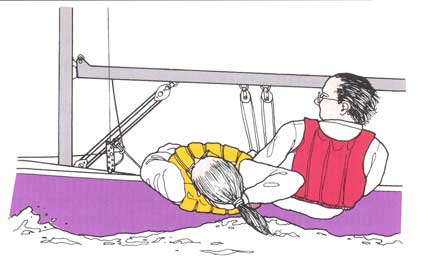 |
Use legal kinetics more often.
‘Kinetics’ is the use of body motion and weight
to help steer and balance the boat while racing.
Though there are some sailors who abuse this
technique, most sailors do not use legal
kinetics nearly as much as they could. For an
in-depth explanation of what’s legal and illegal
under the current rules, check out the rule 42
interpretations on the ISAF web site:
http://www.sailing.org/2004.php.
Copy the fast boats.
Your competitors are a great source of go-fast
ideas, so keep an eye on them. Pay particular
attention to boats that are going faster than
you, and don’t be afraid to copy their set-up.
For example, how are they trimming their sails
and positioning their weight in different
conditions? You can learn a lot just by watching
them on the race course; many of these sailors
will also be willing to share ideas if you talk
with them ashore.
Be ready to change gears constantly.
Sailing is a challenge because conditions are
always changing. You can’t just trim in your
sails, cleat them and expect to win races. You
must be ready to “shift gear,” or adjust the
trim of your boat and sails, constantly to match
changes in the wind and water. As Buddy Melges
often says, you must “present your boat for
Mother Nature.” In other words, you have to
anticipate the puffs, lulls, shifts and waves
that are coming. And when these reach your boat,
you should have already made adjustments for
them (rather than reacting after they hit).
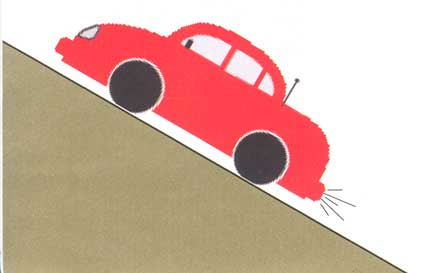 |
Boathandling
Pace yourself when hiking.
Even the most athletic sailors can’t hike all
the way out for an entire race, so save your
best hiking for when it makes the most
difference. Use two hiking modes: 1) “flat-out”
style where everyone straight-leg hikes as hard
as they can (on one-designs) or leans with both
arms and legs straight out (on boats with
lifelines); and 2) “comfort” style, a position
you could hold all the way up the beat. Use
‘flat-out’ mode at crucial times when you need
speed, like right after the start or when you’re
close with another boat. Use ‘comfort’ mode at
other times to conserve energy and strength.
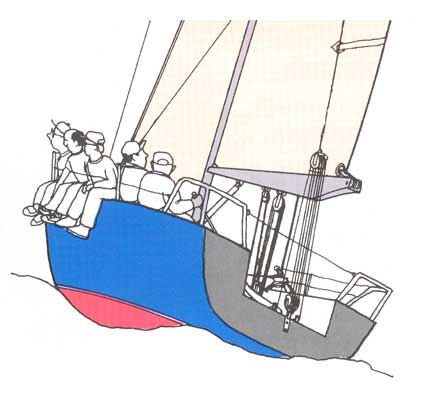 |
Jibe when you’re going fast.
When the wind is blowing hard enough to make
jibing risky, it seems at first that you should
jibe when your speed is slow. but it’s better to
jibe when you are sailing as fast as possible.
Speed has two advantages: 1) it makes your hull
a more stable platform; and 2) the faster you
are going, the less apparent wind pressure
you’ll have on the sails. One of the best times
to jibe is while surfing down a wave. When
jibing in heavy air, speed is your friend.
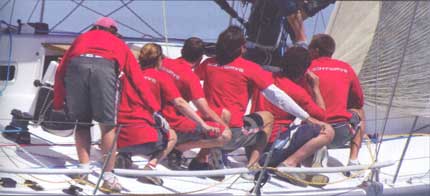 |
Take your chute down early.
One of the costliest mistakes at leeward marks
is leaving your chute up too long. Carrying your
spinnaker for an extra length or two will gain
you only a small distance, but a takedown snafu
can cost you tons. Therefore, unless you are
fighting for an inside overlap, make the smart,
conservative choice by dropping a little early
and not risking a bad takedown.
Don’t maneuver in lulls.
Another good rule of thumb is that you should
never make a maneuver in a lull unless you have
a very, very good reason. Whenever possible,
time your maneuvers (e.g. tacks, jibes) so you
perform them in good wind pressure. If you make
turns without much wind you will lose a lot in
each maneuver.
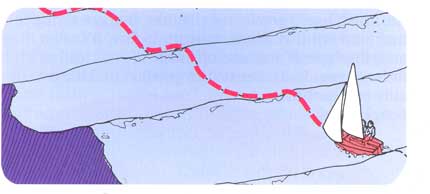 |
In light air, be smooth.
When the wind is light, you don’t want elephants
for crew. So make sure everyone shifts into
“light-air” mode. Plan movements carefully and
avoid unnecessary disruption. When you must
move, be gentle and smooth, as if you are
walking on eggs; otherwise you’ll kill your
momentum. A light-air tack, for example, should
be a smooth and slow event. Don’t just run over
to the other side like you would do in heavy
air, because that could shake all the wind out
of your sails.
Power up before you hit waves.
When you are sailing in waves, it’s important to
make sure your boat is powered up and going fast
when you hit the bad ones. Anticipation is key.
The secret to maintaining speed through a bad
wave is shifting gears before you get to the
wave. That means you need enough warning to
power up your sail plan before the bow digs into
the wave. So as soon as you see a bad wave
coming, make sure everyone knows. Then ease
sheets, bear the boat off for speed, move your
crew weight aft and find a place to hit the
wave.
Keep a lookout in blind spots.
The entire crew can help sail the boat fast and
smart by keeping their heads out of the boat.
Watch for puffs, lulls, waves and converging
boats. Pay special attention to areas where the
helmsperson has a hard time seeing. The two
primary ones are behind his or her back and
behind the genoa or jib. By focusing on these
‘blind spots,’ you’ll avoid last-second
surprises that could interrupt your game plan.
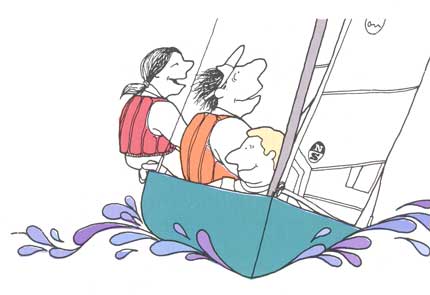 |
Dave publishes the newsletter Speed &
Smarts. For a subscription call: 800-356-2200 or
go to:
www.speedandsmarts.com
TOP
|